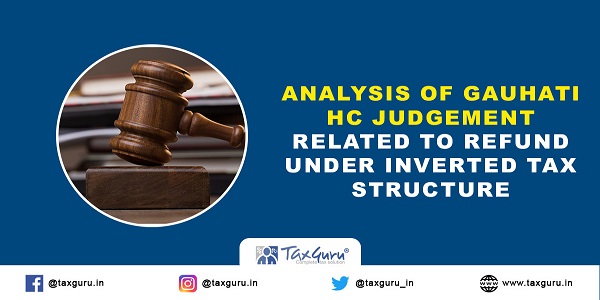Case Law Details
Analysis of the Gauhati High Court judgement holding that refund under inverted tax structure is allowed even if input and output supplies are the same
Introduction
The Gauhati High Court in the case of BMG Informatics Pvt. Ltd. v. Union of India and Others (Judgement dated 02.09.2021 in Case No. WP(C)/3878/2021) has held that refund under inverted tax structure is allowed even if input and output supplies are the same.
While doing so it has stated that provisions of Para 3.2 of CBIC Circular No.135/05/2020-GST, dated 31.03.2020 providing that even though different tax rates may be attracted at different point of time, but refund of accumulated unutilised tax credit will not be available under section 54(3)(ii) of the CGST Act, 2017 in cases where input and output supplies are same, would have to be ignored.

Facts of the case in brief
Petitioner is a company dealing with IT system integrator and is a service provider primarily engaged in sales and service of information and technology products to Government Departments, PSU and to other Research and Educational Institutes located in the North Eastern region. In the course of its business, upon receipt of supply orders from the purchasers, the Petitioner procures materials from the distributors and/or original equipment manufacturers and supplies such material to the customers of above description i.e. Government Departments, PSU and other Research and Educational Institutes located in the North Eastern region. The observation of the departmental authorities that the Petitioner is engaged in trading of technology related products and that it is not a manufacturer of the product concerned is not disputed.
The Assistant Commissioner of CGST, Guwahati passed an order against the Petitioner’s claim of refund under sec. 54(3)(ii) of the CGST Act, rejecting an amount of refund of Rs.3,92,594. The reason cited for rejection was that since the input and output supplies were the same, though it may attract a different tax rate depending upon the class of buyer, the case would not be covered by sec. 54(3)(ii) of the CGST Act. In arriving at the said conclusion, the Assistant Commissioner had relied on Para 3.2 of clarificatory Circular No. 135/05/2020-GST, dated 31.03.2020 which reads as under:
“3.2 It may be noted that refund of accumulated ITC in terms clause (ii) of sub-section (3) of section 54 of the CGST Act is available where the credit has accumulated on account of rate of tax on inputs being higher than the rate of tax on output supplies. It is noteworthy that, the input and output being the same in such cases, though attracting different tax rates at different points in time, do not get covered under the provisions of clause (ii) of sub-section (3) of section 54 of the CGST Act. It is hereby clarified that refund of accumulated ITC under clause (ii) of sub-section (3) of section 54 of the CGST Act would not be applicable in cases where the input and the output supplies are the same.” (emphasis supplied)
Limitation of the power of the Board under section 168(1)
The Gauhati High Court, referring to the impugned Circular and the provisions of section 168(1) of the CGST Act, which grants powers to CBIC to issue such circulars, observed that the said power confines to providing for a given procedure to bring uniformity in the implementation of the Act and that such power cannot be construed to be a power bestowed upon the Board to read and give meaning to the provisions of the CGST Act, 2017 in a manner which would be contrary and in conflict to the provisions of the Act itself.
“Issuing orders, instructions or directions to bring in uniformity in the implementation of the Act and altering the particular provision of the Act itself would be two different acts and for the later the Central Board of Indirect Tax and Customs had not been empowered under the provisions of Section 168(1) of the CGST Act of 2017.” – Gauhati High Court
Conflict between statutory provisions and circular / notification
The High Court went on to observe that the clarification by CBIC in Para 3.2 of Circular No. 135/05/2020-GST, dated 31.03.2020 appears to be in conflict and provides for the contrary to the provisions of section 54(3)(ii) of the CGST Act, 2017. A plain reading of the provisions of section 54(3)(ii) make it explicitly clear that if the input tax credit has accumulated as because the rate of tax on input supply is higher than the rate of tax on output supply, in such event, the assessee would be entitled to a refund of the unutilised input tax credit.
Of course, there is a further exception that in the event the output supplies are subjected to a nil rate or are fully exempted supplies, in such event, the refund of the unutilised input tax credit will not be available under section 54(3)(ii) of the CGST Act. In the instant case, the tax rate applicable in respect of a supply made to a Government Department, PSU or a Research and Educational Institutes within the NE Region is subjected to a partial exemption of GST under Notification No. 45/2017-Central Tax (Rate), dated 14.11.2017. Therefore, it is neither a case of nil rate nor it is a case of full exemption.
It is a settled law that whenever there is a conflict between the provisions of a statutory Act and that of a notification or circular issued by an administrative authority, the provisions of the statutory Act would prevail over such conflicting provisions of a notification or a circular of an administrative authority. Further, the implication of such conflict between the provisions of a statutory Act and that of a notification or circular has been interpreted by the Supreme Court in a plethora of decisions that the provisions of such notification or circular, which is in conflict with the statutory provisions would have to be ignored and not taken into consideration for the purpose of arriving at any such decision.
Conclusion
The High Court, therefore, concluded that in view of the clear unambiguous provisions of section 54(3)(ii), it was of the view that the provisions of Para 3.2 of Circular No. 135/05/2020-GST, dated 31.03.2020 would have to be ignored. As such, rejection of the claim for refund in the order passed by the Assistant Commissioner referring to the provisions of Para 3.2 of Circular No. 135/05/2020-GST, dated 31.03.2020 would be unsustainable in law.
The matter has been remanded back to the Assistant Commissioner of CGST, Guwahati to consider the matter afresh and arrive at his own factual satisfaction as to whether the actual rate of tax on the input supplies made by the petitioner is higher than the actual rate of tax on the output supplies made by them and depending upon the satisfaction that may be arrived to pass a reasoned order on the claim of the petitioner for refund under section 54(3)(ii) of the CGST Act.
The Court reiterated that the provisions of sec. 168(1) of the CGST Act can only be invoked by the CBIC to bring uniformity in the implementation of the CGST Act. In the instant case, when the provisions of sec. 54(3)(ii) are unambiguous and explicitly clear in nature, there is no requirement of bringing in any uniformity in the implementation of the Act and the provisions of sec. 54(3)(ii) would have to be applied in the manner it is provided in the Act itself.





